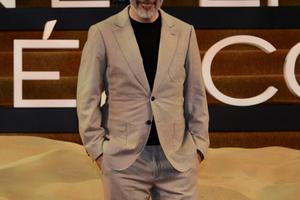Entertainment
/ArcaMax

CBS to end 'The Late Show With Stephen Colbert' next year
CBS said it is canceling “The Late Show With Stephen Colbert” at the end of the upcoming television season in May, a casualty of industry changes that have dealt a crippling blow to advertising revenue.
Colbert announced the news to his audience Thursday during a show taping at the Ed Sullivan Theater in New York. In a clip posted to ...Read more

Simon Cowell to star in new Netflix docu-series
Simon Cowell is set to star in a new reality show for Netflix.
The 65-year-old music mogul - who has enjoyed huge success with TV shows like The X Factor and America's Got Talent - has joined forces with the streaming giant to create Simon Cowell: The Next Act, a docu-series that will launch later this year.
The logline for the show reads: "...Read more

Brooks Nader reveals she tans 'totally naked'
Brooks Nader recommends "tanning totally naked".
The 28-year-old model - who was the covergirl for the Sports Illustrated Swimsuit Issue in 2023 - has shared some of her top beauty tips, revealing that she enjoys tanning naked.
Brooks told Extra: "I would highly recommend just waking up every morning and tanning totally naked. Lay in the sun. ...Read more

Aaron Phypers rubbishes Denise Richards' 'hurtful' allegations
Aaron Phypers has described Denise Richards' abuse allegations as "completely false and deeply hurtful".
The 52-year-old actor has been accused of physical abuse by his estranged wife, but Aaron insists that "any suggestion of abuse is categorically untrue".
In a statement to People, he said: "I want to address recent rumors and speculation ...Read more

CBS to end 'Late Show with Stephen Colbert' in May 2026
NEW YORK — CBS announced on Thursday it plans to end “The Late Show with Stephen Colbert” in May 2026, citing a “financial decision.”
Colbert took over hosting duties in 2015 following the retirement of David Letterman, who joined the network in 1993. The show was routinely the highest-rated late-night program during Colbert’s ...Read more

Chris Martin may have outed couple 'having an affair' at Coldplay concert
NEW YORK — Chris Martin caused a stir at the Boston Coldplay concert with a quip about a couple caught in a cozy moment on the jumbotron, video shows.
The clip seemingly features Astronomer CEO Andy Byron with his arms wrapped around a woman who resembles his company’s chief people officer, Kristin Cabot, at the Wednesday night show in ...Read more

The Senate voted to defund NPR and PBS. How will local stations cope?
Public media outlets around the country were preparing for the worst. Early Thursday morning, the worst arrived.
The U.S. Senate voted to approve the Trump White House's proposal to claw back $9 billion in federal funding previously allocated for foreign aid and public broadcasting. The 51-48 Senate vote means that the Corp. for Public ...Read more

'She cared': Slain 'American Idol' music supervisor Robin Kaye remembered by peers
LOS ANGELES — Veteran music supervisor Robin Kaye, best known for her lengthy tenure on "American Idol," leaves behind a legacy of "light, kindness, and joy."
Singer-songwriter and former "Idol" contestant Didi Benami in a Tuesday Instagram story praised Kaye as "one of the kindest souls I've ever had the privilege of working with" as she ...Read more

Zac Brown Band announces 4 shows at the Sphere in 'dream come true' experience
LOS ANGELES — Ooh, Las Vegas: The Zac Brown Band is set to bring their southern twang to the Las Vegas Sphere.
According to their website, the band will play four shows across two weekends in December at the venue. The first performance is scheduled for Dec. 5, the same day they plan to release their eighth album, "Love & Fear."
"Bringing ...Read more

Elmo returns to his wholesome self, promoting love instead of racism and Epstein claims
Elmo's everlasting mission of kindness and all things wholesome is back in full swing, days after the puppet's official X account platformed racist and antisemitic remarks, and popular claims about the sex trafficking investigation of Jeffrey Epstein.
"Thank you for being kind to Elmo and all the people in your neighborhood," the iconic "Sesame...Read more

Nick Jonas thinks health scare brought his family 'closer'
Nick Jonas' family became "closer" after his dad suffered a cancer scare.
Kevin Jonas Sr was diagnosed with colon cancer back in 2017 and he's been in remission since 2018 - but Nick believes that the worrying health scare has actually served to unite his family.
The 32-year-old singer - who stars in the Jonas Brothers alongside his siblings, ...Read more

Aaron Phypers rubbishes Denise Richards' abuse allegations
Aaron Phypers claims that Denise Richards' abuse allegations have been "conjured up".
The 52-year-old actor has been accused of physical abuse by his estranged wife, with Denise alleging that he was repeatedly violent and threatening towards her - but Aaron has now rubbished those claims.
Speaking to Us Weekly, he said: "Not true. Conjured up....Read more

Arnold Schwarzenegger recalls 'falling in love with America'
Arnold Schwarzenegger "fell in love with America" as a child.
The 77-year-old actor was born and raised in Austria, but he developed an ambition to move to the US during his younger years.
Schwarzenegger told The Wall Street Journal newspaper: "At age ten, I fell in love with America. That came from watching film rolls in school. The teacher ...Read more

Connie Francis, singer who made Fort Lauderdale spring break famous, dies at 87
MIAMI — Connie Francis, the international pop singer who put Fort Lauderdale on the musical map with her spring break standard “Where the Boys Are” and who had an unexpected career resurgence at 87 with a song she’d forgotten she recorded, died Wednesday night.
The “Pretty Little Baby” singer, who lived in Parkland, was hospitalized...Read more

With 'Ruthless' and Barstool deals, Fox and others chase digital media audiences
As legacy news brands turn to podcasters to court online audiences, another digital media upstart has been invited to sit at the grown-ups table.
Fox News Media this week signed a licensing deal with the makers of "Ruthless," a popular conservative podcast, a move aimed at expanding the network's digital reach.
The five-year-old podcast is co-...Read more

Would you buy a ticket a year early for Christopher Nolan's next movie?
LOS ANGELES — Tickets to see Christopher Nolan's upcoming film, "The Odyssey," are now on sale for Imax 70mm screenings — a year ahead of the film's release.
Sixteen theaters across the U.S. are participating in these first screenings, including seven in California. As of Thursday morning, several of these theaters were already sold out for...Read more

Perry Farrell, Dave Navarro exchange wildly differing lawsuits over imploded Jane's Addiction tour
LOS ANGELES — The members of Jane’s Addiction were flinging civil lawsuits at one another Wednesday like it was nothing shocking, with each side registering arguments about a physical altercation that started onstage in 2024 and took the tour — and the reunited band — down with it.
First, Dave Navarro, Eric Avery and Stephen Perkins ...Read more

Relay star Lily James eyes 'unlikely roles'
Lily James is keen to play "unlikely roles".
The 36-year-old actress - who stars alongside Riz Ahmed and Sam Worthington in the thriller film Relay - has revealed that she's eager to challenge herself in her professional life.
Asked if she would've been interested in Relay if it was more "conventional", Lily told The Hollywood Reporter: "...Read more

Barbara Broccoli hails 'fantastic filmmaker' Denis Villeneuve
Barbara Broccoli is "thrilled" Denis Villeneuve is directing the next James Bond movie.
The 65-year-old producer has given up creative control of the Bond franchise to Amazon MGM Studios, but she's convinced that Denis is the perfect candidate to helm the next movie.
During an appearance on the Kermode on Film podcast, Barbara said: "He's a ...Read more

'I Know What You Did Last Summer' review: First one wasn't good either
The rebooted "I Know What You Did Last Summer" feels more like a recycled "I Know What You Did Last Summer."
This legacy sequel to the 1997 horror hit, which followed in "Scream's" reawakening of the teen horror machine, follows the familiar beats of the original film, except with less personality and a total lack of suspense. With results this...Read more











